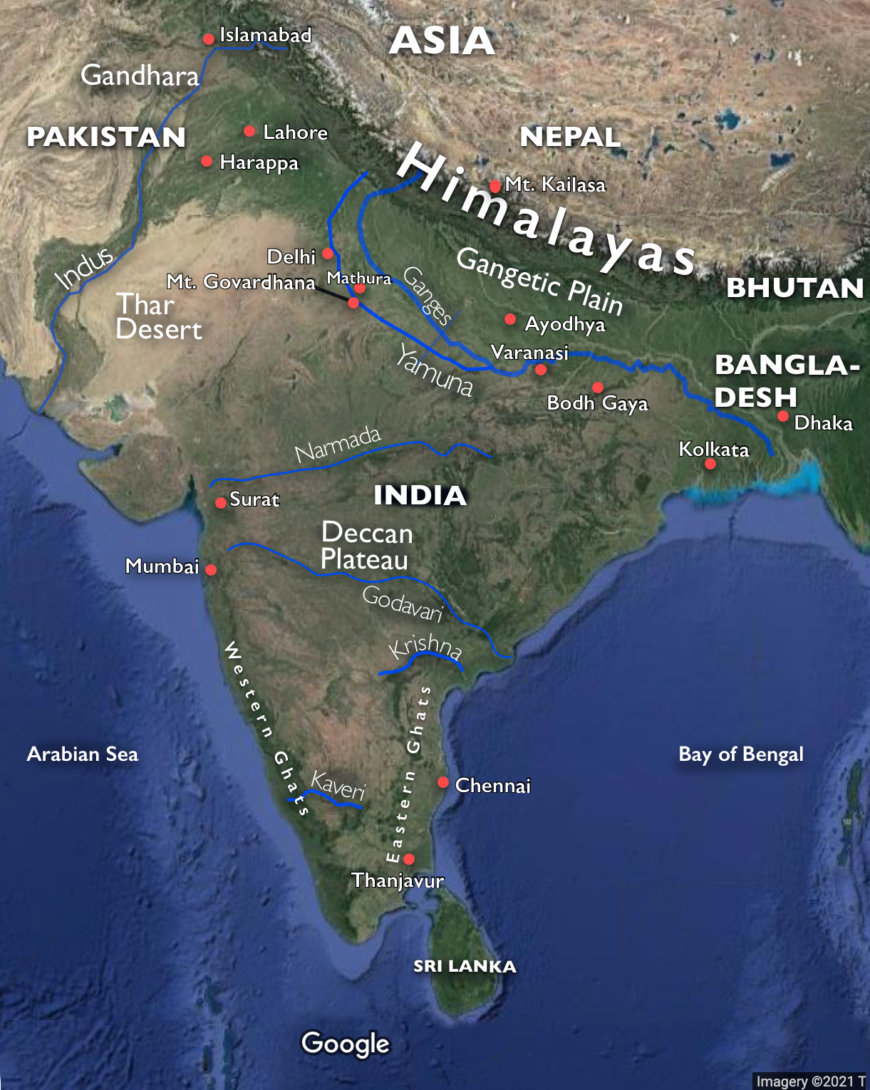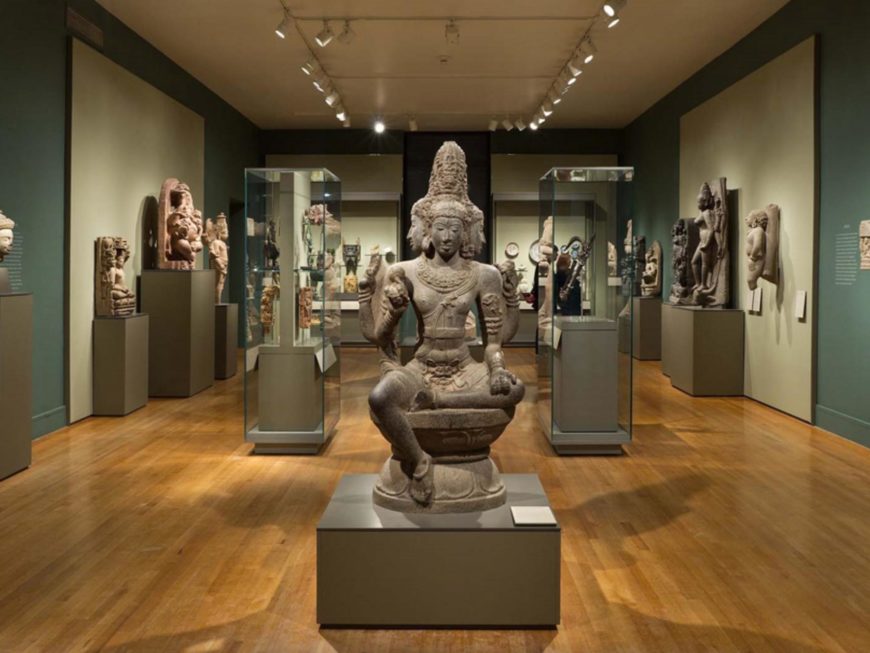
South and Southeast Asia Gallery, Museum of Fine Arts, Boston (photo: MFA Boston)
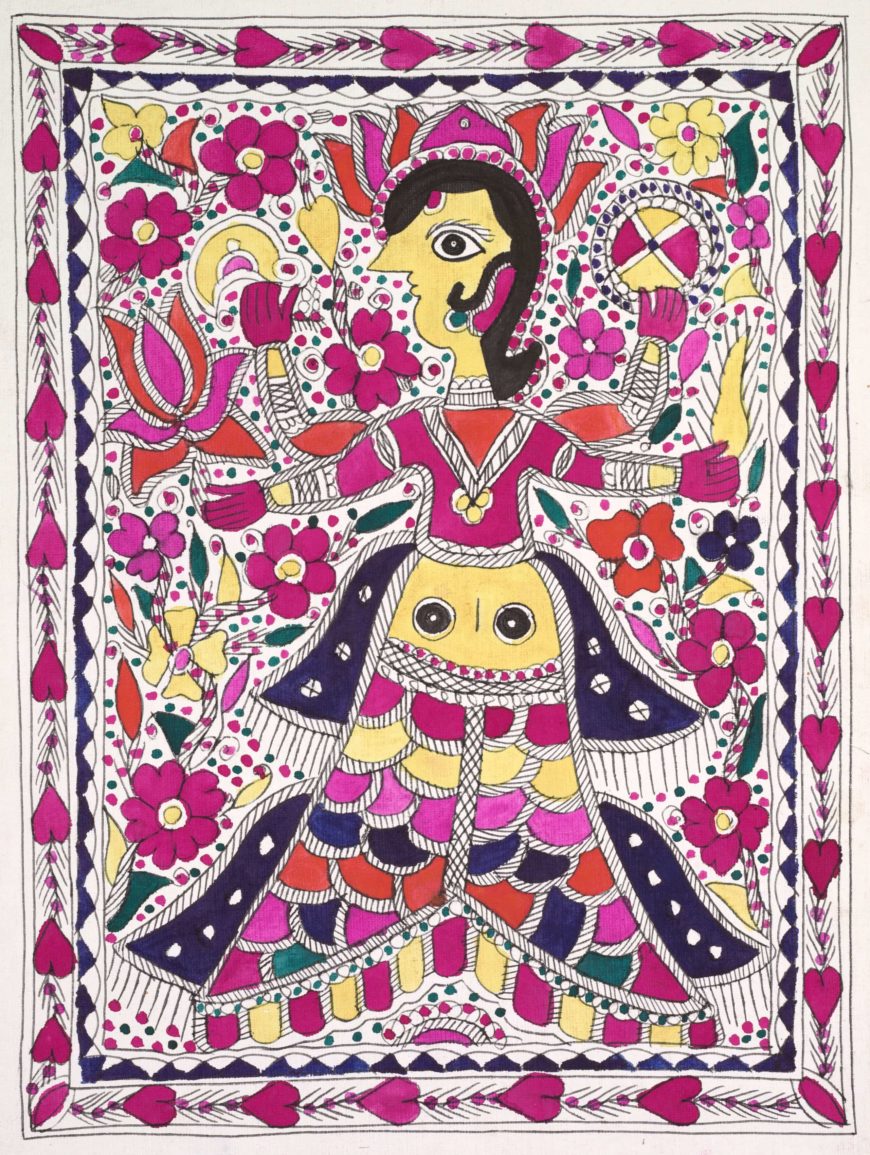
Large, multi-armed figure with hearts in margin, 1900s, Eastern India, Bihar State, Mithila or Madhubani School, 20th century, ink and color on paper; overall: 36.2 x 27 cm (The Cleveland Museum of Art)
Challenges
The diverse objects from South Asia that fill the world’s museums and are valued as important works of art can sometimes be daunting to teach and study. Indeed the term “art” itself is problematic—often imposed onto “non-Western” cultures through European definitions and values—and has come to define objects that were made for many reasons beyond aesthetic pleasure.[1] For example, how should we begin to consider diverse material and visual culture that spans from prehistory to the present; was commissioned by everyone from kings to priests to villagers; and was enjoyed and valued in a variety of social situations—from displays of political power, to religious worship, to the practice of everyday life?
To complicate matters further, how can we approach art from the vast geography of the Indian subcontinent when much of the region was divided into separate nations in the second half of the 20th century, each with their own contemporary identities and artistic priorities? Dynastic categories like “the Gupta-period” or “the Cholas” can be useful for studying many of South Asia’s most treasured objects (for example, the Mathura Buddha from the Kimbell Art Museum). However this emphasis on elite and royal patronage neglects the many wonderful vernacular objects made for “the folk” or popular audiences (for example, Madhubani painting).
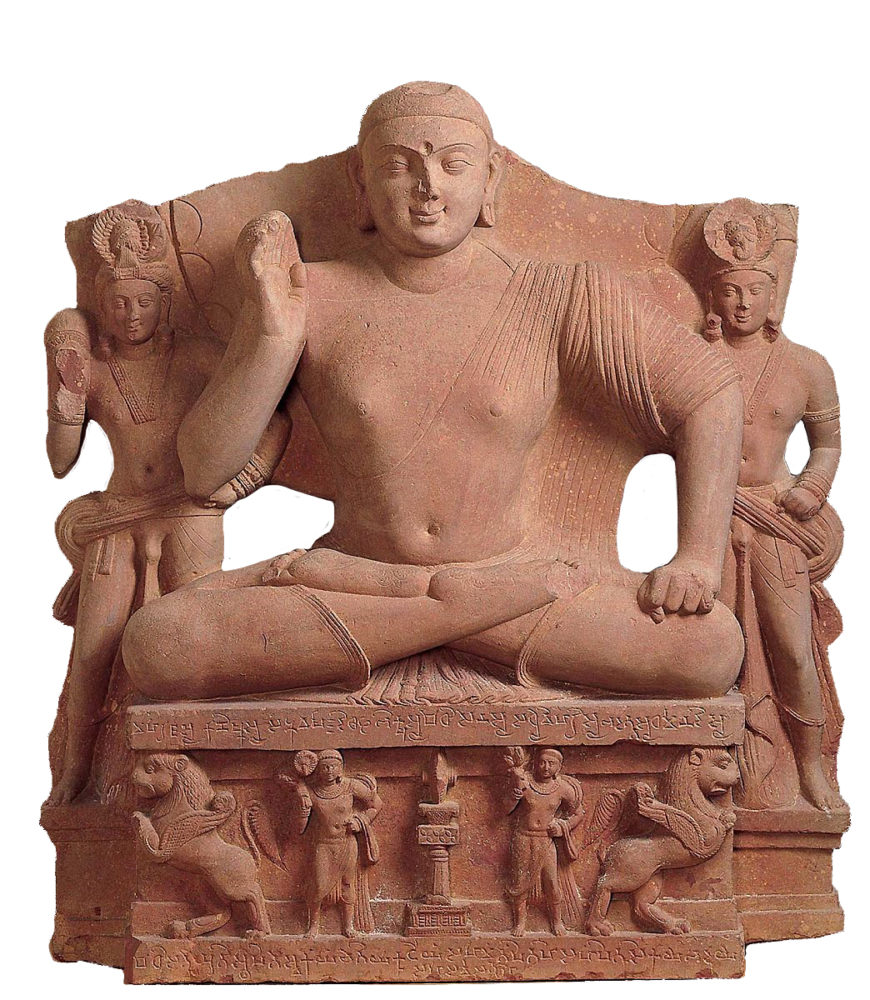
Seated Buddha with Two Attendants, c. 132 C.E., from Mathura, red sandstone, 36 5/8 x 33 5/8 x 6 5/16 inches (Kimbell Art Museum)
Religious distinctions and the legacy of colonialism
Early European travellers to India focused their attention on sacred images and sites, a legacy of which we have inherited today and one that is reflected in the vast collections of Buddhist, Jain, and Hindu objects that dominate the South Asia galleries of museums around the world. [2] Following this pattern, when British scholars began to closely study the ancient sites and objects of South Asia in the late 18th and early 19th centuries, they continued to rely on religious distinctions, which later translated into categories of art (e.g. “Hindu art,” “Buddhist art,” “Islamic art”). Unfortunately, this narrow approach does not leave room for syncretic artistic practices (where different religious traditions come together) like those seen at Sanchi, the Qutb complex, under Vijayanagara patronage, or through cross-cultural exchanges at Mughal and Rajput courts, to name just a few.[3] Neither does it create a space for the numerous material things—from luxurious court accessories to coveted trade commodities to highly prized family heirlooms—which were made or used outside of religious contexts. Even the oldest objects from South Asia, like the ubiquitous seals, terracotta vessels, and female figurines of the Indus Valley Civilization, do not fit easily within a classification based on religion; their original uses and meanings are still unknown to us and they were made long before the emergence of Hinduism as we understand it today. A taxonomy that focuses on religion belies pluralistic cultural practices on the subcontinent, the multivalent religious identities of past patrons and makers, and art made for secular contexts. Ultimately this approach reinforces Orientalist constructions of South Asia as an inherently “spiritual” and “traditional” place (and therefore distinct from the “material” and “modern” West).
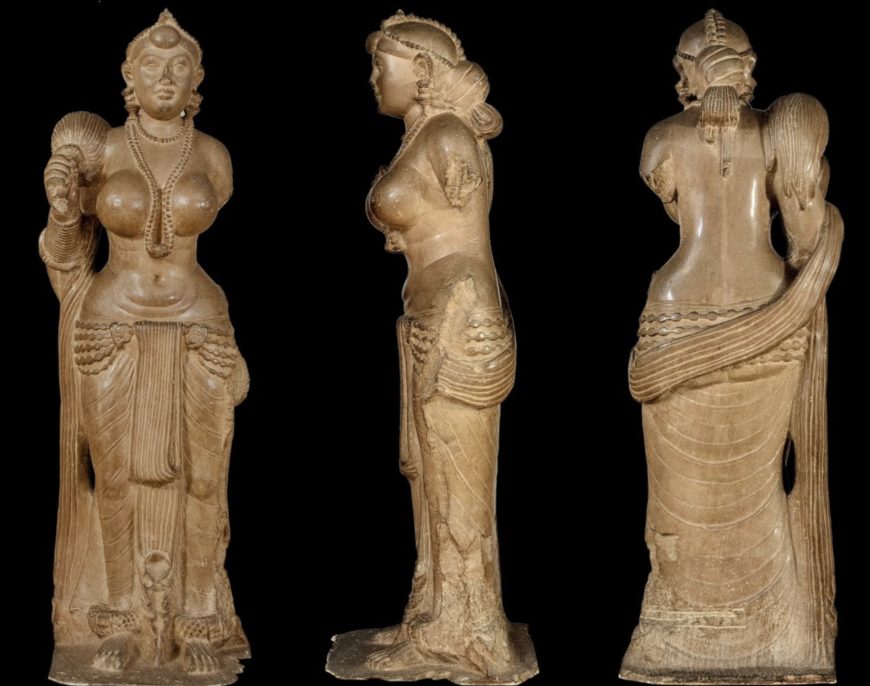
Didarganj Yakshi, Mauryan, sandstone, figure: 62 inches (Bihar Museum, India)
In fact, it is this more recent history of South Asia—from the period of British colonial intervention to the present—that has directly affected our ability, as contemporary scholars and students of South Asian art, to interpret even the most ancient of objects and artistic practices from the subcontinent. As historian Tapati Guha-Thakurta has astutely pointed out, “ancient artifacts [from South Asia], in their status as art treasures . . . are born of distinctly recent histories. Their antiquity, like their iconographic and aesthetic significance, come to us as uniquely modern values, transmitted through the specificities of India’s colonial and nationalist pasts and her postcolonial present.”[4] For example, the “discovery” in 1917 of the famous Didarganj yakshi, which is now one of the more iconic objects of early Indic art, spurred the founding of architectural and art historical societies throughout India, and intensified efforts on the subcontinent (which at that time was largely under British Raj rule) to find, document, historicize, and museumify India’s artistic pasts.[5] Art historian Partha Mitter has convincingly shown that attempts by the British Raj to classify and categorize South Asian art were constrained by their own Victorian perspectives and their misguided attempts to fit South Asian art into periods and themes prevalent in Europe.[6]
Chronological groupings?
Challenges also exist when trying to approach the study of South Asian art chronologically. For example, in creating chronological groupings are we inadvertently privileging objects and sites made before the start of the Mughal Empire in 1526 C.E. or before European trading companies entered into the robust Indian Ocean trade around the turn of the 17th century? And if so, how might such framing of South Asian art history underscore Orientalist and nationalist stereotypes that imagine a “glorious” Hindu / Buddhist / Jain past (about which we still know very little) that ended with the arrival of Islam and Europeans? With chronological groupings are we reinforcing Eurocentric periodization, to align, for example, with Medieval Europe (c. 5th century C.E. to c. 1400 C.E.) or the Classical Mediterranean World (c. 6th century B.C.E. to c. 5th century C.E.)? Furthermore, what do we do with an object like the Didarganj yakshi that has roots in the 2nd or 1st century B.C.E., but also is very much an object of the 20th century?
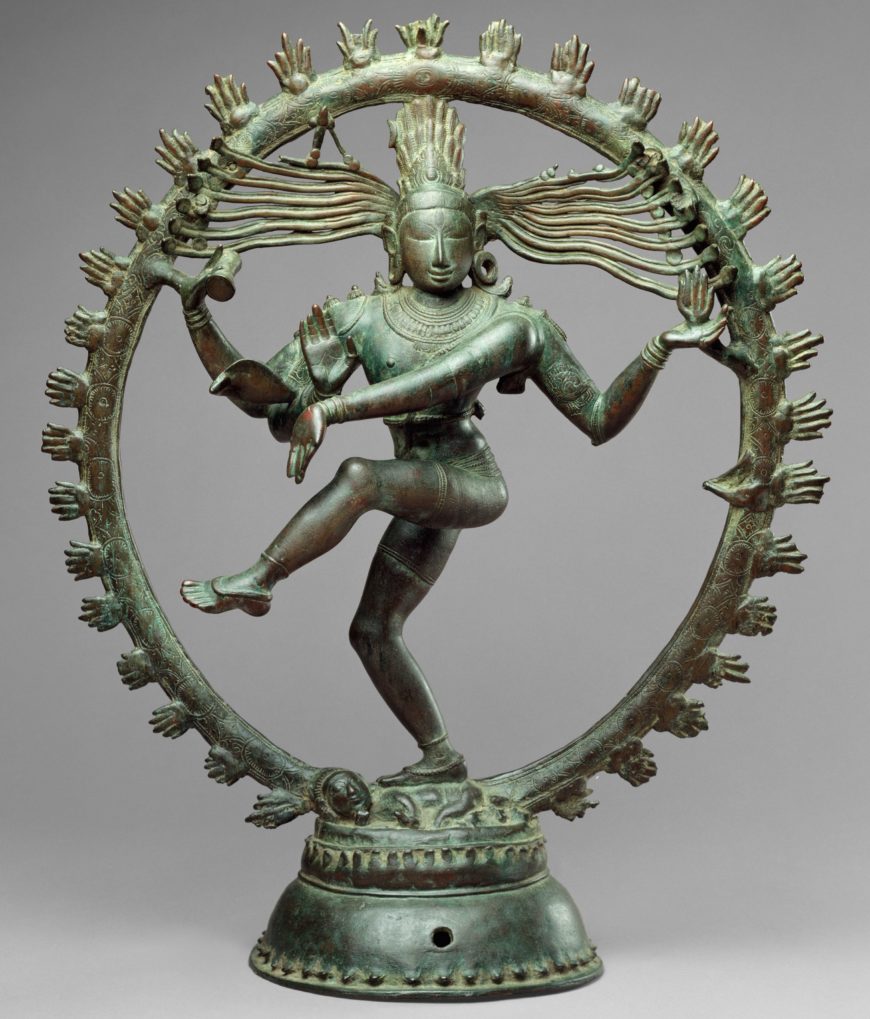
Shiva as Lord of the Dance (Nataraja), c. 11th century, Copper alloy, Chola period, 68.3 x 56.5 cm (The Metropolitan Museum of Art)
It seems no one approach is perfect and in fact what is most needed are perspectives that allow for overlapping categories, porous boundaries, and multiple histories of objects. Drawing inspiration from Arjun Appadurai’s ground-breaking 1986 edited volume The Social Life of Things, we should remember that most objects and sites from South Asia have experienced many lives and have complex biographies.[7] Guha-Thakurta similarly reminds us that objects shed one “envelope” and acquire another in their move from place to place (e.g. from a Hindu temple to an art museum), and concomitantly their value shifts—from cult value to exhibition value.[8] Indeed, the role of museums in shaping our understanding of South Asian art is significant: these institutions have defined both what we see and how we see it, and, for better or for worse, they have facilitated the creation of artistic canons.[9] Some objects—like Chola-period bronze sculptures of Shiva Nataraja—are able to move easily in and out of these various identities and to be understood simultaneously as both an art object and a sacred icon.[10] Accordingly our approach to organizing South Asian art and the categories we choose to present this material needs to be flexible and acknowledge the multiple identities and meanings of objects alongside disruptive colonial interventions and complex historiography.
Opportunities for other approaches
One strategy for doing this is a multi-pronged approach: to organize a study of South Asian art chronologically as well as geographically and, in some cases, dynastically to account for the rich regional variations in the subcontinent that support diverse linguistic, cultural, and artistic practices over time. Historiographic and thematic approaches can also work nicely and many scholars have successfully framed chronological, geographic, and dynastic studies of South Asian art through the lens of broader ideas, themes, and histories of scholarship and collecting.[11] Even if we are unable to free ourselves entirely from an art history that emerged from European colonialism, there are still opportunities for approaching and teaching the study of South Asian art through thematic means, moving away from a dependence on chronological and geographical frames. For example, we could look across time and place at objects according to material (e.g. clay, paint, stone) and techniques of making; or consider diverse sites and objects according to how they represent constructions of identity and power, public and private space, death and the afterlife, ritual and belief, or global encounters and interactions. The possibilities and iterations are numerous and offer inspiration for future approaches.
The importance of geography
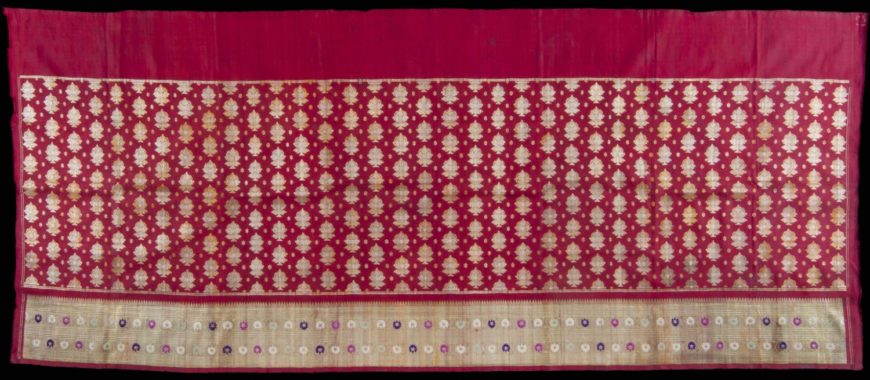
Banarsi Fabric, made in Benares (present-day Varanasi, India), 19th to mid 20th century, burgundy red, multicolored, and gold metallic silk supplementary weave, 207 × 86.4 cm (Philadelphia Museum of Art)
Understanding geography is particularly important for the study of art of South Asia, not only because the topography of the region is so diverse, but also because, for many who live on the subcontinent, the landscape itself is considered to be sacred. In this way, geography can be a subject of study as much as it is a site for the origins of things. For example, the high mountain peaks of the Himalayas are the abode of the gods, rivers are manifestations of goddesses (for example, the goddess Ganga is the River Ganges), and numerous temples and sites of worship for many religious devotees (not just Hindus) are revered as tirthas or sacred “crossings” between heaven and earth.[12] Indeed landmarks in this sacred geography, such as rivers like the Yamuna, mountains like Govardhana (just east of Mathura) and Kailasa, or forests like those near Ayodhya are subjects in themselves and have been depicted by artists working in everything from paint to stone to cloth. Even epic stories such as The Ramayana can be interpreted through a mapping of the physical landscape of South Asia. [13] The importance of geography is also apparent in architectural interventions into the landscape and poetic descriptions of places that are both naturally-existing and intentionally-made.

In the city of Delhi: left: Qutb Minar, 1198 (photo: Dr. Moumita Sahana, CC BY-SA 4.0); center: Mirak Mirza Ghiyas and Sayyid Muhammad, Humayun’s tomb, 1562-71 (photo: AJ Nayak, CC BY-SA 4.0); left: Herbert Baker, Secretariat building, 1910s, New Delhi (photo: Laurie Jones, CC BY-SA 2.0)
Sites for artistic production also center on geography and the specificities of a place, sometimes more so than the patronage of a particular king. Many textiles, for example, have names that connect them to specific places: Banarasi Brocade, Kanchipuram Silks, and Kashmiri Shawls reference important weaving centers in Varanasi (previously Benares), Kanchipuram, and Jammu-Kashmir, respectively. Similarly, individual cities have served pivotal roles over the course of South Asia’s artistic history: the city of Mathura was a major center for stone carving and flourished under both the Kushans and the Gupta kings, before becoming an important center for artistic production and pilgrimage (beginning in the 16th century) as the birthplace of Krishna and the mythological landscape in which the Hindu god lived and loved [14]; Thanjavur was a center for Chola rule, the site of a great temple dedicated to Shiva, and connected to an eponymous reverse glass painting tradition that continues to flourish today[15]; the city of Delhi is not only the capital of India but also home to great architectural works patronized by sultanate rulers, the Mughals, and the British Raj.[16]
Organization on Smarthistory
With all this in mind and to facilitate a multidimensional and accessible approach to studying the many diverse arts of South Asia, we have organized material using the following working categories:
Prehistory to 500 B.C.E.
While there exist Neolithic-era cave paintings at prehistoric sites such as Bhimbetka, most of the earliest material objects from South Asia come from the ancient peoples of the Harappan Civilization (also known as the Indus Valley Civilization). The Harappan Civilization flourished from c. 2600 to 1900 B.C.E. throughout the northern part of the subcontinent, before the arrival of nomadic peoples known as the Aryans who moved into the region from Central Asia and brought with them the language of Sanskrit and the Vedas.
500 B.C.E. to 600 C.E.
We begin to see monumental carving in stone emerge during the rule of the powerful Maurya kings (c. 321–185 B.C.E.) whose capital at Pataliputra was at the heart of the Gangetic River Valley (also known as the Indo-Gangetic Plain), the fertile region along the Ganges River that was home to some of the earliest cultures of South Asia. This time period also includes important objects and sites that form under the reign of influential kingdoms including the Satavahanas, centered further south in the Deccan; the Kushans of the Northwest who patronized art at their two capitals, Mathura and Gandhara; and the Guptas, whose influence was felt throughout much of the subcontinent and into Sri Lanka and Southeast Asia. It is also during this time that we see the beginnings of an established iconography for objects associated with Hinduism as well as the emergence of important heterodox religions such as Buddhism and Jainism.
600 to 1200 C.E.
Following the end of Gupta rule over the subcontinent in 543 C.E., art is once again produced in a number of diverse regional kingdoms, and particularly there is a flourishing of Hindu and Jain temple architecture in the Deccan and the southern part of the subcontinent through Pallava and Chola rule—dynasties with ancient roots who dominate these later centuries. It is also during this time that we see religious belief systems like Buddhism and Hinduism travel outside South Asia and take hold in East and Southeast Asia. In Sri Lanka, during the reigns of the Anuradhapura and Polonnawura kingdoms, works of art connected with both Buddhism and Hinduism emerged. Robust Indian Ocean trade continues with South Asia a fulcrum of linguistic, cultural, and artistic exchange that connects Africa, Asia, and the Islamic World.
1200 to 1500 C.E.
With the start of the Delhi sultanate in 1206 C.E. in the northwestern part of the subcontinent, Islam becomes a major cultural and artistic influence in the region. Sultanate kingdoms move outside of Delhi—to Bengal, Malwa, and the Deccan—each patronizing vibrant artistic forms and ruling over a religiously plural populace. While Hinduism and Jainism continue to be important, this period also sees the rise of Islamicate culture in the southern Deccan through dynamic, syncretic sites and objects patronized under Hindu rulers of the Vijayanagara empire (established 1336 C.E.). Increased evidence for Indian Ocean trade (West and East) and pan-Islamic patterns of movement across Asia enrich artistic forms that emerge in South Asia during this period.
1500 to 1857 C.E.
The end of Delhi sultanate rule coincides with the defeat of the Lodi dynasty by the Timurid ruler Babur in 1526 C.E. who established the Mughal Empire, a dominant kingdom that ruled much of the Indian subcontinent for the next two centuries. While the capital of the Mughal Empire was centered in the northern part of the subcontinent, Babur’s great-great-great grandson Aurangzeb pushed the extent of the Mughal Empire into the Deccan. Several smaller Hindu kingdoms in the south, including the Nayakas, emerged after the fall of the Vijayangara empire (in 1565 C.E.) and were great patrons of art alongside the Deccani sultanates of Bijapur and Golconda. It is during this time that we also see the rising influence of European trading companies in the region, dominated by the British East India Company who arrived at the port of Surat (in Gujarat) in 1608. This period concludes with the infamous Sepoy Mutiny of 1857 which marked the end of the British East India Company and the official start of British imperial rule (known as British Raj) in 1858.
1857 to present
With increased British presence and political control on the subcontinent, new artistic forms and practices emerged. Government-run art and design schools that drew upon European curricula were increasingly popular in the second half of the nineteenth century, training students in techniques of linear perspective and the use of oil paints. This period also includes the rise of anti-colonial nationalists movements and the work of avant-garde modernists whose artistic affiliations and interactions include those in Bombay, Calcutta, and Lahore as well as in Paris, London, and New York. Following the end of colonial rule in 1947 and the establishment of India and Pakistan as independent nations (followed in 1971 by the creation of Bangladesh and in 1972 with Sri Lanka assuming the status of a Republic independent of British dominion), the art of this period speaks to the experiences of diverse artists and cultural practitioners who are actively working today both in South Asia and its global diaspora.
Notes
- See Carolyn Dean ,”The Trouble with (the Term) Art” in Art Journal, vol. 65, no. 2 (Summer, 2006), pp. 24-32. Art Historian Stella Kramrisch, an important scholar in the history of South Asian art history, offers “shilpa” in lieu of “art” as a Sanskrit term that refers to everything from pottery to sculpture to perfume to textiles to architecture. See Stella Kramrisch, “Traditions of the Indian Craftsmen,” in The Journal of American Folklore, vol. 71, no. 281 (1958), pp. 224-230.
- For an expanded discussion on British approaches to and interpretations of Indian art, see Partha Mitter, Much Maligned Monsters: A History of European Reactions to Indian Art (Chicago: University of Chicago Press, 1977).
- See Finbarr B. Flood, “Appropriation as Inscription: Making History in the First Friday Mosque of Delhi,” in Richard Brilliant and Dale Kinney, eds., Reuse Value: Spolia and Appropriation in Art and Architecture from Constantine to Sherrie Levine (Ashgate, 2011), pp. 121-147, and Philip Wagoner’s essay “‘Sultan among Hindu Kings’: Dress, Titles, and the Islamicization of Hindu Culture at Vijayanagara,” The Journal of Asian Studies, vol. 55, no. 4 (Nov., 1996), pp. 851-880.
- Tapati Guha-Thakurta, Monuments, Objects, Histories (Columbia University Press, 2004), p. 205.
- For a detailed discussion of this yakshi see chapter 7 in Guha-Thakurta, “‘For the Greater Glory of Indian Art’: Travels and Travails of a Yakshi” in Monuments, Objects, Histories; and Richard H. Davis, Lives of Indian Images (Princeton: Princeton University Press, 1999).
- For an expanded discussion on British approaches to and interpretations of Indian art, see Partha Mitter, Much Maligned Monsters: A History of European Reactions to Indian Art (Chicago: University of Chicago Press, 1977).
- Arjun Appadurai, ed., The social life of things: commodities in cultural perspectives (Cambridge University Press, 1986).
- Guha-Thakurta, “Our Gods, their museums’: The contrary careers of India’s art objects, Art History, vol. 30, no. 4, p. 628.
- Kavita Singh and Saloni Mathur, ed. No Touching, No Spitting, No Praying: The Museum in South Asia (Routledge, 2015).
- Guha-Thakurta, “Our Gods, their museums’: The contrary careers of India’s art objects, Art History , vol. 30, no. 4, p. 654.
- For textbooks that work well in survey or introductory courses, see Vidya Dehejia, Indian Art (London: Phaidon, 1997) for an example of a chronological-geographic-dynastic approach that also incorporates thematic categories; see Partha Mitter, Indian Art (Oxford, 2001) for an example that includes discussions of historiography.
- See Diana Eck, India: A Sacred Geography (Harmony, 2012).
- See Jonah Blank, Arrow of the Blue-Skinned God: Retracing the Ramayana Through India (Houghton Mifflin, 1992).
- See Sugata Ray, Climate Change and the Art of Devotion: Geoaesthetics in the Land of Krishna, 1550-1850 (University of Washington Press, 2019).
- See Vidya Dehejia, Art of the Imperial Cholas (Columbia University Press, 1990).
- William Dalrymple, The City of Djinns: A Year in Delhi (HarperPress, 2011). For an expansive discussion of the concept of “place” in South Asia, see Rebecca Brown and Deborah Hutton, eds., Rethinking Place in South Asian and Islamic Art, 1500 to Present (Routledge / Ashgate, 2017).
Additional resources:
Catherine B. Asher and Cynthia Talbot, India before Europe (Cambridge: Cambridge University Press, 2006).
Vidya Dehejia, Indian Art (London: Phaidon, 1997).
Susan L. Huntington, The Art of Ancient India: Buddhist, Hindu, Jain (New York: Weatherhill, 1985).
Partha Mitter, Indian Art (Oxford: Oxford University Press, 2001).
Gayatri Sinha, ed., Indian Art: An Overview (New Delhi: Rupa and Co, 2003).

